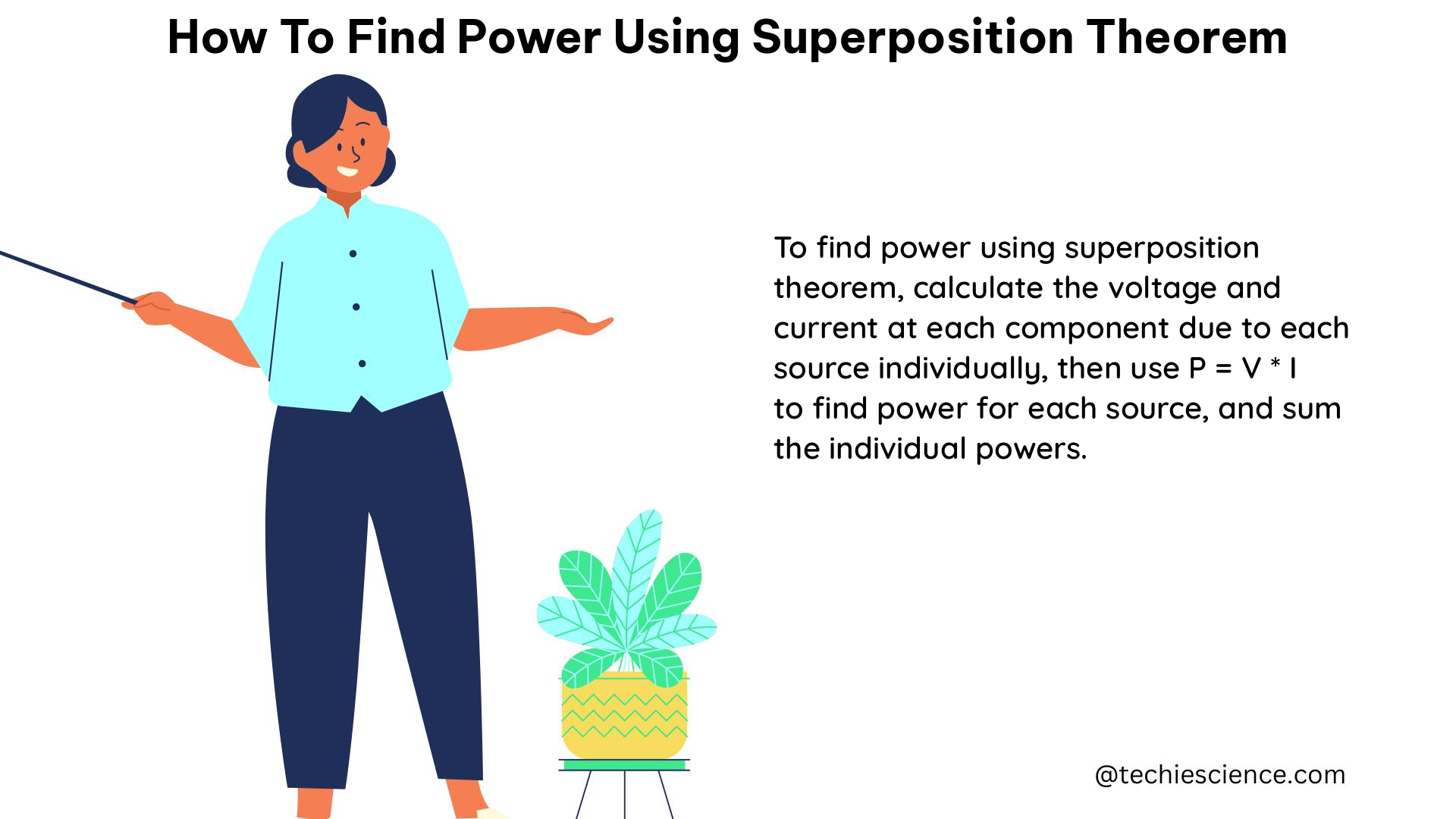The superposition theorem is a powerful tool in electrical engineering and circuit analysis, allowing us to simplify the calculation of voltages, currents, and power in complex linear circuits. This comprehensive guide will walk you through the step-by-step process of finding power using the superposition theorem, providing you with a deep understanding of the underlying principles and practical applications.
Understanding the Superposition Theorem
The superposition theorem states that the voltage or current at any point in a linear circuit is the algebraic sum of the voltages or currents produced by each source acting alone. This means that we can analyze a circuit by considering the effects of each source individually and then adding the results to find the total voltage, current, or power.
The key assumptions for the superposition theorem to be applicable are:
- The circuit must be linear, meaning that the relationship between voltage and current must be linear (i.e., Ohm’s law must hold).
- The circuit must contain only independent voltage and current sources, and no dependent sources.
- The circuit must not contain any non-linear elements, such as diodes, transistors, or switches.
Steps to Find Power Using Superposition Theorem

To find the power in a circuit using the superposition theorem, follow these steps:
Step 1: Identify the Sources
Identify all the voltage and current sources in the circuit. These will be the independent sources that you will analyze individually.
Step 2: Isolate a Single Source
Isolate a single source in the circuit by replacing all other sources with their Thevenin or Norton equivalent. This means that you will replace voltage sources with short circuits and current sources with open circuits.
Step 3: Calculate the Resistor Currents and Voltages
Using Ohm’s law, calculate the current and voltage across each resistor in the circuit due to the isolated source. This will give you the individual contribution of that source to the overall circuit behavior.
Step 4: Calculate the Power
Calculate the power dissipated in each resistor using the formula:
P = I^2 * R
where P is the power, I is the current flowing through the resistor, and R is the resistance.
Step 5: Repeat for All Sources
Repeat steps 2-4 for each source in the circuit, isolating one source at a time.
Step 6: Find the Total Power
The total power in the circuit is the sum of the powers calculated for each individual source:
P_total = P_1 + P_2 + ... + P_n
where P_1, P_2, …, P_n are the powers calculated for each source.
Example: Applying the Superposition Theorem
Let’s consider a simple circuit with two voltage sources, V1 and V2, connected in series with a resistor R. To find the total power using the superposition theorem, we need to follow the steps outlined above.
- Identify the sources: The sources in this circuit are
V1andV2. - Isolate a single source: Let’s start with
V1. ReplaceV2with a short circuit. - Calculate the resistor currents and voltages: The current flowing through the resistor due to
V1isI1 = V1 / R. The power dissipated in the resistor isP1 = I1^2 * R. - Isolate the other source: Now, replace
V1with a short circuit and consider the effect ofV2. - Calculate the resistor currents and voltages: The current flowing through the resistor due to
V2isI2 = V2 / R. The power dissipated in the resistor isP2 = I2^2 * R. - Find the total power: The total power in the circuit is the sum of the powers calculated for
V1andV2:
P_total = P1 + P2
P_total = (V1^2 / R) + (V2^2 / R)
P_total = (V1^2 + V2^2) / R
This example demonstrates the straightforward application of the superposition theorem to find the total power in a simple circuit. However, the real power of this theorem lies in its ability to handle more complex circuits with multiple sources and resistors.
Advanced Considerations and Limitations
While the superposition theorem is a powerful tool, it does have some limitations:
- Non-linear Circuits: The superposition theorem only applies to linear circuits. It cannot be used to analyze non-linear circuits, such as those containing diodes, transistors, or switches.
- Dependent Sources: The theorem assumes that the circuit contains only independent voltage and current sources. It cannot be used to analyze circuits with dependent sources, such as voltage-controlled current sources or current-controlled voltage sources.
- Mutual Inductance and Coupling: The superposition theorem does not directly account for the effects of mutual inductance or electromagnetic coupling between circuit elements. Additional analysis may be required to incorporate these effects.
Despite these limitations, the superposition theorem remains a fundamental and widely-used technique in circuit analysis, particularly for linear DC circuits. By understanding its principles and applying the steps outlined in this guide, you can effectively use the superposition theorem to find the power in a wide range of electrical circuits.
References
- Superposition Theorem | DC Network Analysis | Electronics Textbook – https://www.allaboutcircuits.com/textbook/direct-current/chpt-10/superposition-theorem/
- A Theorem on Power Superposition in DC Networks – TechRxiv – https://www.authorea.com/users/662795/articles/676331-a-theorem-on-power-superposition-in-dc-networks
- Superposition Theorem Solve A Linear DC Network – https://www.emcourse.com/news-blog/superposition-theorem-solve-linear-dc-network
- Superposition Theorem – YouTube – https://www.youtube.com/watch?v=EX52BuZxpQM
- Superposition Theorem – Explanation, Solved Example, Limitations – https://byjus.com/physics/superposition-theorem/

The lambdageeks.com Core SME Team is a group of experienced subject matter experts from diverse scientific and technical fields including Physics, Chemistry, Technology,Electronics & Electrical Engineering, Automotive, Mechanical Engineering. Our team collaborates to create high-quality, well-researched articles on a wide range of science and technology topics for the lambdageeks.com website.
All Our Senior SME are having more than 7 Years of experience in the respective fields . They are either Working Industry Professionals or assocaited With different Universities. Refer Our Authors Page to get to know About our Core SMEs.